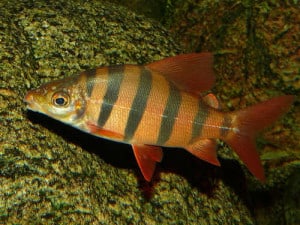
Common name: Six-banded Distichodus
Scientific name: Distichodus Sexfasciatus
Average Adult Fish Size: 30 inches / 75cm, though rarely attains more than 16 inches / 40cm in aquaria.
Place of Origin: Cameroon, Democratic Republic of Congo, Tanzania, and Lake Tanganyika.
Typical Tank setup: Decorate with large rocks and large, smooth driftwood/bogwood pieces. It will readily munch on most aquarium plants, but if live plants are a must use species such as Anubias or Bolbitis, as most fish leave these alone.
Recommended Minimum Aquarium Capacity: Juveniles can easily be housed in aquariums as small as 30 gallons / 120 litres, but fully grown individuals will need a minimum of a 140 gallon / 560 litre aquarium if housed by themselves, and a much larger aquarium if housed as part of a community tank.
Compatibility: Sexfasciatus are somewhat unpredictable. While some specimens remain peaceful with similarly-sized species, others can become very spiteful as they mature. Certainly don’t attempt to keep one of these with much smaller or shy species. Tankmates in a big tank could include bichirs, large characins, cyprinids, catfish and Loricariids.
Similarly, while juvenile specimens will shoal together peacefully, they become increasingly aggressive towards one another as they grow. An enormous tank would be needed in order to keep a group of adults.
Temperature: 22 – 26 Deg C / 72 – 79 Deg F
Water chemistry: pH 6.0 – 7.5
Feeding: Large Sexfasciatus will readily eat feeder fish, but this is not the best diet for them as the transmittance of disease is too great of a risk. It is best to feed them a varied diet of pellets and chunk frozen foods such as brine shrimp or beef heart. Earthworms, shelled mussels, and whole market shrimp are also relished. Plant matter should also be fed on a regular basis. Veggie pellets and wafers along with shelled green peas, blanched zucchini, and spinach are good choices for this fish.
Sexing: Unknown
Breeding: Not known to have been bred in captivity.
Additional Information: A regular water change schedule is required to keep this fish healthy. They are prone to eye and body fungus if nitrate levels get too high. This fish is prone to jump so a heavy and tight fitting lid is a must. This is the most common of the few Distichodus species regularly seen in the hobby, and sadly, it is often sold as being suitable for the general community tank. This is clearly not the case in terms of both its temperament and potential size. Do not buy one unless you have the facilities to house it for life. It is usually seen for sale at a couple of inches long, and at this size is a very attractive orange and black striped fish with bright red finnage. Unfortunately, much of this color and pattern fades as it grows. It is depressing to think where most specimens end up, as adults are rarely seen for sale.


Related Posts
Croaking Gourami – Trichopsis vittatus
Benthochromis Tricoti
Large-eyed Mouthbrooder – Callochromis Macrops